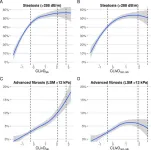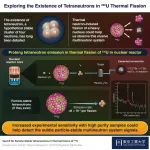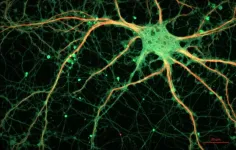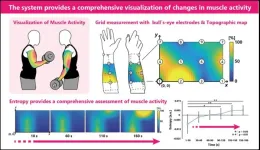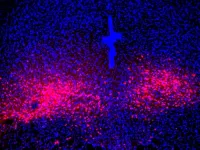(Press-News.org) Chicago, January 4, 2024 — The JAMA Network today announces a new class of seven academic physicians and nurses selected for a new program to provide junior faculty and current research fellows opportunities to learn about biomedical journals and scientific publication. This inaugural group of fellows will spend six months immersed as part of the JAMA editorial team to obtain direct exposure to the editorial review process and enhance their skills in scientific communication.
Fellows will be assigned to a current JAMA editor for mentorship, attend manuscript meetings, participate in discussions about research design, data validity, potential clinical importance, and conduct peer-review on manuscripts. Fellows will also have the opportunity to join the clinical review and education, multimedia, or social media teams.
By the end of the program, this group will develop a deep understanding of the various editorial roles involved at a journal like JAMA.
“This is a tremendous, unique opportunity for both the fellows and the JAMA Network,” said Kirsten Bibbins-Domingo, M.D., Ph.D., M.A.S., editor in chief of JAMA and the JAMA Network. “I’m excited for our new fellows to gain an insider perspective on medical editing and publishing. Such skills will be useful as they continue as authors of academic publications and hopefully will inspire some to become journal editors as well.”
Applications opened in the fall to current scholars in the National Clinician Scholars Program and the Harold Amos Medical Faculty Development Program of the Robert Wood Johnson Foundation.
Fellows were chosen based on their demonstrated interest in medical publishing, medical education or research, or a career in academic medicine, as well as their communication skills and knowledge of medical research and study design.
The seven editorial fellows are:
K. Jane Muir, Ph.D., R.N.
Dr. Muir is a postdoctoral research fellow in the National Clinician Scholars Program and the Center for Health Outcomes and Policy Research at the University of Pennsylvania. Her research focuses on improving timely and equitable patient outcomes in the U.S. through models of care that leverage registered nurses.
Crystal E. Brown M.D., M.A.
Dr. Brown is an Assistant Professor in the Division of Pulmonary, Critical Care, and Sleep Medicine and an Adjunct Assistant Professor in the Department of Bioethics and Humanities at the University of Washington. Her research interests focus on racial inequities during serious illness and at end-of-life.
Hermioni Amonoo, M.D., M.P.P., M.P.H.
Dr. Amonoo is the Carol C. Nadelson, M.D. Endowed Chair in Psychiatry at the Brigham and Women’s Hospital (BWH) and clinician educator in the Departments of Psychiatry and Psychosocial Oncology and Palliative Care at BWH and the Dana-Farber Cancer Institute (DFCI), where she directs the Well-being and Cancer Research Program. Her research aims to understand the well-being needs of vulnerable cancer populations to develop innovative and practical psychological and digital therapeutics for patients with cancer and their caregivers.
Michael O. Mensah, M.D., M.H.S., M.P.H.
Dr. Mensah is a Yale National Clinician Scholars Program and Recognizing and Eliminating Disparities in Addiction through Culturally-informed Healthcare Scholar and Ph.D. candidate at Yale University. His early-career research and writing concerns racial and gender equity within medicine's workforce.
Jasmine L. Travers, Ph.D., M.H.S., R.N., A.G.P.C.N.P.-B.C.
Dr. Travers is an assistant professor of nursing at NYU Rory Meyers College of Nursing. Her research is dedicated to improving health outcomes and reducing health disparities experienced by older adults.
Abigail Arons, M.D.
Dr. Arons is an internal medicine-pediatrics physician and a second-year fellow in the National Clinician Scholars Program at UCSF. Her current research focuses on diabetes prevention in young adults.
Lisa McElroy, M.D., M.S.
Dr. McElroy is an Assistant Professor of Surgery and Population Health Sciences at Duke University. Her research examines the influence of organizational characteristics on clinical outcomes of high cost, high acuity patients.
“For most who start out their careers as academic clinicians or researchers, the inner workings of a journal can be inscrutable,” says Deputy Editor Joseph Ross, M.D. “This unique opportunity will give talented scholars who are early in their career an insider perspective into what it takes to be a medical journal editor.”
For more information, contact JAMA Network Media Relations at 312-464-JAMA (5252) or email media relations.
END
JAMA names seven academic physicians and nurses to new Editorial Fellowship Program
2024-01-04
ELSE PRESS RELEASES FROM THIS DATE:
New technique could improve liver fibrosis treatment
2024-01-04
Chronic liver disease, a growing threat to global health, often progresses silently in its early stages. Detecting its precursor, steatotic liver disease (SLD), and advanced liver fibrosis before complications arise is crucial to prevent devastating outcomes. The newly developed Chronic Liver Disease (CLivD) score offers a promising non-invasive approach to this challenge.
In a recent study involving a US general population sample, researchers explored the CLivD score’s ability to identify SLD and advanced fibrosis, assessed using liver stiffness measurement (LSM). The study also evaluated the potential ...
Hunting for the elusive tetraneutrons with thermal fission
2024-01-04
Tetraneutron is an elusive atomic nucleus consisting of four neutrons, whose existence has been highly debated by scientists. This stems primarily from our lack of knowledge about systems consisting of only neutrons, since most atomic nuclei are usually made of a combination of protons and neutrons. Scientists believe that the experimental observation of a tetraneutron could be the key to exploring new properties of atomic nuclei and answering the age-old question: Can a charge-neutral multineutron system ever exist?
Two recent experimental studies reported the presence of tetraneutrons in bound state and resonant state (a state that decays ...
Understanding the role of a new enzyme in the development of autism spectrum disorder
2024-01-04
Over the past decades, scientists have made substantial progress unveiling the underlying mechanisms behind many psychiatric disorders. Every year, new genetic mutations or protein dysregulations are identified as potential culprits for the symptoms, and sometimes even the root causes of complex neurological diseases, including autism spectrum disorder (ASD), schizophrenia, and Alzheimer’s.
Despite these efforts, the precise roles of several proteins involved in brain function remain obscure. Such is the case for indoleamine 2,3-dioxygenase 2 (IDO2), an enzyme expressed in the brain and metabolized by the ...
An innovative approach for evaluating muscle coordination and fatigue
2024-01-04
Surface electromyography (sEMG) is a traditional method used to measure the electrical activity of muscles during physical activity. This method has remained unchanged for over 70 years and involves the use of two standard approaches. The first involves a pair of electrodes—metals that conduct electricity through non-metals—to record from a particular muscle, while the second employs a grid of electrodes arranged in a small rectangular layout in order to measure the potential distribution of intra-muscle activity. However, these approaches only provide a measurement of a single muscle at a time. Thus, limiting our understanding of how our muscles coordinate ...
New theoretical framework unlocks mysteries of synchronization in turbulent dynamics
2024-01-04
Weather forecasting is important for various sectors, including agriculture, military operations, and aviation, as well as for predicting natural disasters like tornados and cyclones. It relies on predicting the movement of air in the atmosphere, which is characterized by turbulent flows resulting in chaotic eddies of air. However, accurately predicting this turbulence has remained significantly challenging owing to the lack of data on small-scale turbulent flows, which leads to the introduction of ...
Scientists use high-tech brain stimulation to make people more hypnotizable
2024-01-04
How deeply someone can be hypnotized — known as hypnotizability — appears to be a stable trait that changes little throughout adulthood, much like personality and IQ. But now, for the first time, Stanford Medicine researchers have demonstrated a way to temporarily heighten hypnotizablity — potentially allowing more people to access the benefits of hypnosis-based therapy.
In the new study, to be published Jan. 4 in Nature Mental Health, the researchers found that less than two minutes of electrical ...
Salk scientists uncover key brain pathway mediating panic disorder symptoms
2024-01-04
LA JOLLA (January 4, 2024)—Overwhelming fear, sweaty palms, shortness of breath, rapid heart rate—these are the symptoms of a panic attack, which people with panic disorder have frequently and unexpectedly. Creating a map of the regions, neurons, and connections in the brain that mediate these panic attacks can provide guidance for developing more effective panic disorder therapeutics.
Now, Salk researchers have begun to construct that map by discovering a brain circuit that mediates panic ...
Gender parity in autism research: Synaptic similarities challenge focus on male models
2024-01-04
New study reveals striking similarities in synaptic abnormalities and behavioral patterns between male and female mouse models of autism spectrum disorder (ASD). The study challenges the traditional focus on male subjects in ASD research and highlights the critical importance of including both sexes in investigations. This finding urges a pivotal shift in the scientific community's approach to understanding and addressing ASD, emphasizing the necessity of considering both males and females to comprehensively ...
Tiredness experienced by Long-COVID patients has a physical cause
2024-01-04
Researchers from Amsterdam UMC and Vrije Universiteit Amsterdam (VU) have discovered that the persistent fatigue in patients with long-COVID has a biological cause, namely mitochondria in muscle cells that produce less energy than in healthy patients. The results of the study were published today in Nature Communications.
"We're seeing clear changes in the muscles in these patients," says Michèle van Vugt, Professor of Internal Medicine at Amsterdam UMC.
25 long-COVID patients and 21 healthy ...
New roles for autophagy genes in cellular waste management and aging
2024-01-04
Autophagy, which declines with age, may hold more mysteries than researchers previously suspected. In the January 4th issue of Nature Aging, it was noted that scientists from the Buck Institute, Sanford Burnham Prebys and Rutgers University have uncovered possible novel functions for various autophagy genes, which may control different forms of disposal including misfolded proteins—and ultimately affect aging.
“While this is very basic research, this work is a reminder that it is critical for us to understand whether we have the whole story about the different genes that have been related to aging or age-related diseases,” said Professor ...
